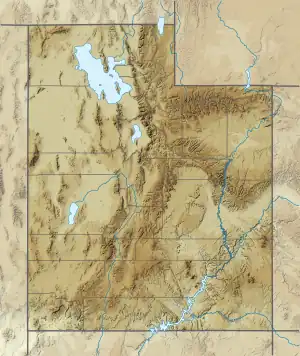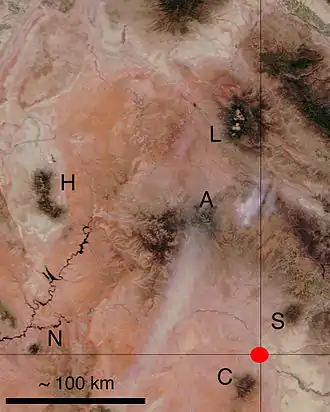Abajo Mountains
The Abajo Mountains, sometimes referred to as the Blue Mountains, are a small mountain range west of Monticello, Utah, south of Canyonlands National Park and north of Blanding, Utah. The mountain range is located within the Manti–La Sal National Forest. The highest point within the range is Abajo Peak at 11,360 feet (3,463 m).[1]
| Abajo Mountains | |
|---|---|
| Blue Mountains | |
 Abajo Mountains near Monticello | |
| Highest point | |
| Peak | Abajo Peak |
| Elevation | 11,360 ft (3,460 m) |
| Coordinates | 37°50′34″N 109°27′46″W |
| Geography | |
 Abajo Mountains | |
| Country | United States |
| State | Utah |
| Parent range | Rocky Mountains |
This mountain range, like both the La Sal Range and Henry Mountains in the same part of the Colorado Plateau, is formed about igneous intrusions that are relatively resistant to erosion. Some of these intrusions form laccoliths emplaced at depths of a few kilometers. The predominant igneous rock is porphyritic hornblende diorite. Ages of intrusion in the Abajo Mountains fall in the interval from 22 to 29 million years.[2]
These mountain ranges are part of the Colorado Plateau province west of the greater ranges of the Rocky Mountains. The laccolith ranges are much younger and have a very different geologic origin.[2]
The range was reputedly named by the Spanish in the 1700s, the name "Abajo" meaning "low".[1][3]

References
- Van Cott, John W. (1990). Utah Place Names: A Comprehensive Guide to the Origins of Geographic Names. Salt Lake City: University of Utah Press. p. 1. ISBN 9780874803457. Retrieved 21 April 2016.
- Friedman, Jules D.; Huffman Jr, Curtis (1998). "Laccolith Complexes of Southeastern Utah: Time of Emplacement and Tectonic Setting - Workshop Proceedings" (PDF). United States Geological Survey Bulletin. 2158. Retrieved 21 April 2016.
- Gannett, Henry (1905). The Origin of Certain Place Names in the United States. U.S. Government Printing Office. p. 22.